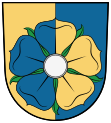Sezimovo Ústí
| Sezimovo Ústí | ||||
|---|---|---|---|---|
|
||||
| Basic data | ||||
| State : |
|
|||
| Region : | Jihočeský kraj | |||
| District : | Tábor | |||
| Area : | 953 ha | |||
| Geographic location : | 49 ° 23 ' N , 14 ° 41' E | |||
| Height: | 399 m nm | |||
| Residents : | 7,257 (Jan 1, 2019) | |||
| Postal code : | 391 01 | |||
| structure | ||||
| Status: | city | |||
| Districts: | 2 | |||
| administration | ||||
| Mayor : | Mgr. Ing.Martin Doležal | |||
| Address: | Dr. Beneše 21 391 01/02 Sezimovo Ústí |
|||
| Municipality number: | 553069 | |||
| Website : | www.sezimovo-usti.cz | |||
Sezimovo Ústí (German Alttabor ) is a city with 7233 inhabitants (2018) in the Czech Republic . It is located four kilometers south of Tábor on the right of the Lainsitz and belongs to the Okres Tábor . The cadastral area is 953 ha.
geography
The city is located 399 m above sea level. M. at the confluence of the Kozský potok in the Lainsitz at the transition from the Wittingau pan to the Wlaschimer hill country . The railway and the European route 55 / state route 3 from Tábor to Soběslav run through Sezimovo Ústí . One and a half kilometers east of the city, above the Kozský potok valley, lies the ruins of Kozí Hrádek castle . To the northeast is the Tábor airfield (LKTA).
Neighboring towns are Tábor in the north, Zárybničná Lhota in the northeast, Červený Dvůr and Turovec in the east, Planá nad Lužnicí in the south, Lhota Samoty and Zhoř u Tábora in the southwest, Radimovice u Želče , Dolejšův Dvůr and Větrovyice in the west and Větrovyice.
history
Old Town
The first written mention of the place took place under the name de Auzt in 1262, when a Dominican monastery at the confluence of the Kozský potok in the Lainsitz was mentioned. From 1322 the place was owned by the Sezema de Vsk family from the Witigonen family . The nickname Ústí Sezemova has been handed down from 1419. Ústí had developed into a small town in inheritance , in which, in addition to the Auzt monastery, a Roman Catholic church, a rectory, the manor house and a hospital for the poor were built. The new town of Ústí (Nové Město) developed on the left bank of the Lainsitz. The city also had two suburbs.
Since 1377, the easternmost leaves Castle Kozí Hrádek (dt .: Goat castle ) show was named as its first owner Vlček z Kozího. The further history of the castle and town is closely linked. The owners of the Jan and Ctibor z Ústí manors gave shelter to Jan Hus from 1413 to 1414 , who then traveled to Krakovec Castle . Kozí Hrádek Castle was burned down by Albrecht II in 1438 and remained desolate .
The city became a center of the Hussites , who gathered here in late February 1420. Because of the very unfavorable strategic location of Ústí, the Hussites moved a little later north to the old fort on Mount Tabor, where they founded the new town of Tábor . The old town of Sezimovo Ústí was set on fire and burned down. Later one was on the deserted village Vorwerk built, which was named Starý Tábor in the 17th century.
New city
Between 1827 and 1828 the cantor Antonín Svatoš from Tábor had another settlement built on the site of the old town, which was first called Svatošov. Over the years it grew into a town and was given the original name Sezimovo Ústí again.
With the construction of the railways from Prague to Budweis and Vienna , Sezimovo Ústí received a rail connection in 1869. At that time, 946 people lived in Sezimovo Ústí.
In the 1930s, the city expanded and today's Sezimovo Ústí II district was built to the south-east of the railway, which in its early years looked more like a suburban campsite. The Czechoslovak President Edvard Beneš and his brother Vojta Beneš , who liked to be guests in Soukenický Mlýn, were frequent guests in the city . From 1930 to 1931, President Beneš had the architect Petr Kropáček build a representative villa in the provenance style at the mouth of the Kozský potok and the Lainsitz.
From 1939 the Sezimovo Ústí II settlement was established in the corridors of the former Velký Dvůr municipal courtyard by the Bata company .
Sezimovo Ústí had the largest population in its history in 1980 with 8885 inhabitants.
Attractions
- Kozí Hrádek Castle
- Luna natural monument
- Edvard Beneš villa with memorial
- Church of the Exaltation of the Holy Cross, built in 1835
City structure
No districts are shown for the city of Sezimovo Ústí. It consists of the localities Sezimovo Ústí I and II.
Personalities
sons and daughters of the town
- Václav Kaplický (1895–1982), poet
- Jiří Kaloč (* 1943), academic painter
- František Němec (* 1943), actor
They lived and worked in the city
- Jan Hus lived on Kozi Hrádek from 1413 to 1414
- Edvard Beneš was several times a guest in Sezimovo Ústí, had a villa built for himself from 1930–1931 and after returning from exile often stayed there with his wife to relax, where he died in 1948.


